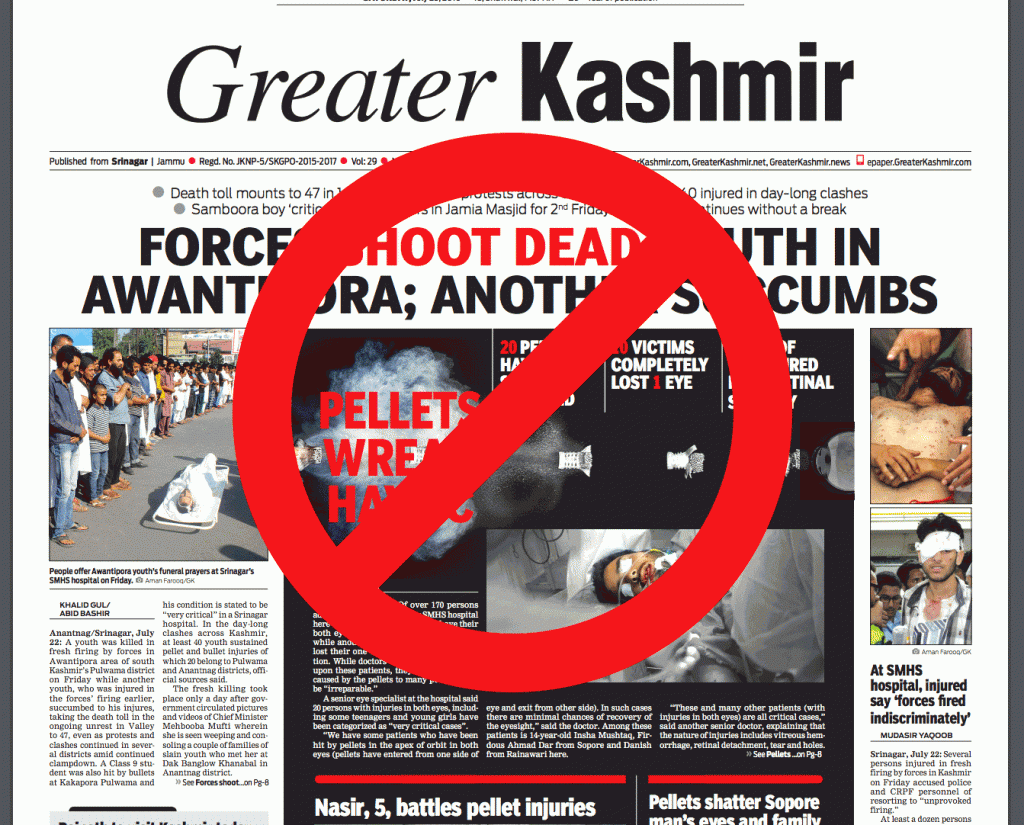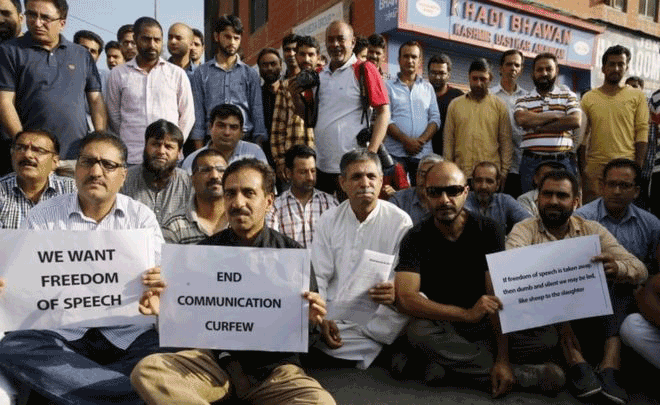Muzzling the Press: News blackout in Kashmir
By From Shujaat Bukhari in Srinagar | Newsbeat International | Published 8 years ago
Kashmir has erupted again and, that too, in a violent mode that claimed 48 lives. Nearly 3,000 people were injured in the latest uprising, the highest ever number in any phase of unrest in Kashmir over the last 26 years. Curfew was imposed for more than a fortnight and life paralysed.
Governments in both Delhi and Srinagar failed to anticipate the outrage that followed the killing of the wanted Hizbul Mujahideen commander, Burhan Wani. The state reacted in its usual brutal manner to crush the new phase of resistance. This time it was not just force that was used to crush the dissent but a complete communication blockade was imposed to cut off Kashmir from the rest of the world. In addition to blocking social media through the internet, the government imposed a ban on newspapers that could not hit the stands for five days.
On July 16, Kashmir woke up to no newspapers as the printing presses of major dailies had been raided, copies seized and some staff arrested. This was followed by an official gag, communicated by government spokesman Naeem Akhtar, who also happens to be the Education Minister in the Peoples Democratic Party-Bharatiya Janta Party coalition government. Naeem Akhtar termed the ban a reluctant decision. “It is a temporary measure to address an extraordinary situation… In our opinion, there is an emotional lot, very young, out in the field, who get charged due to certain projections in the media, which results in multiplication of tragedies,” he was quoted as saying in The Indian Express. When the ban on newspapers evoked a sharp reaction, with even Prime Minister Narendra Modi seeking details on the issue, the state government went on the back foot, denying that there was a ban in place. But the media resisted and forced the Chief Minister to “deeply regret” the decision.
The media blockade is nothing new to Kashmir. Since the outbreak of armed rebellion in Kashmir in early 1990, the media in Kashmir has worked on the razor’s edge. A small community, it has lost 13 of its members to bullets from either side. Life threats, intimidation, arrests, censorship and beatings have been part of the daily grind which an average journalist undergoes. It is difficult to operate from this highly militarised zone as journalists have become the target of both state and non-state actors. If an atrocity by the government forces is reported, a journalist may be dubbed “anti-national,” while highlighting violations by non-state actors or the extra-political activities of separatists would be taken to mean that he is “anti-tehreek” (anti-movement) or a collaborator. A sword hangs over his head in either case, and there is no way for him to please both of the warring sides.
When I was told about the raid on the press, I was not unnerved as this did not come as a shock in a situation that has engulfed Kashmir for over nine days. After the killing of Burhan Wani, the valley has seen unprecedented unrest, reminding us of a similar situation in 2010 when 130 people were killed in firing by police and paramilitary forces in attempts to quell civilian protests against the Indian state. Imposing an information blockade was part of the state strategy in 2010 as well, and the scene is rewinding this time. All mobile services, including data, with the sole exception of the government owned Bharat Sanchar Nigam Limited (BSNL) have been barred, cable TV is off the air and even newspapers have been asked to cease publication. A handful of government owned broadband connections are keeping a connection with the rest of the world alive. It is learnt that BSNL services were also a target, but that would have crippled the official communication link and created problems for pilgrims on the annual Amarnath Yatra to the Holy Cave in Pahalgam woods, in South Kashmir.
The newspapers had a tough time in the 2008 and 2010 public unrest when the government forced them to suspend publication by imposing restrictions. When Afzal Guru was hanged in 2013, copies of newspapers were seized in a similar fashion and not allowed to circulate.
With an almost complete ban on social media, the government has now chosen to close down the last source of information as well. Newspapers, in any case, are the institutions that would project the true picture before the readers. They would crosscheck the facts and not go by hearsay. By banning them, a government that is desperately grappling to normalise the situation has opened up space for rumour mills to flourish that could aggravate the already charged atmosphere. When every means of communication is blocked, newspapers are the only source of information for Kashmiris. The ban was meant to keep people in the dark about the gory incidents that were taking place across the length and breadth of Kashmir.
While the ban, according to the government, was a reluctant decision to “ensure peace,” the same reasoning does not seem to apply to a vast section of TV media in India that is provoking the people by its one-sided and polarised coverage. The TV studios of certain channels turn into war rooms at prime time and the venom they are spitting out against the minority community, and in particular Kashmiris at this juncture, is adding to the unrest in Kashmir. It seems that TV anchors have taken on the prime role of defending the country. India’s jingoistic and ultra-nationalistic media has changed the fundamentals of journalism, setting new rules for coverage. But that does not warrant restrictions like the ones in place in Kashmir. All the democratic spaces in Kashmir are choked, adding to the angst that created the situation in the first place.
Ten years ago, Kashmiris had chosen the path of non-violence but New Delhi failed to acknowledge this change. They are now looking at armed militants as saviours again, to realise their political dream. New Delhi’s only response is to crush their sentiments, and muzzle the media as well by declaring a press emergency.




